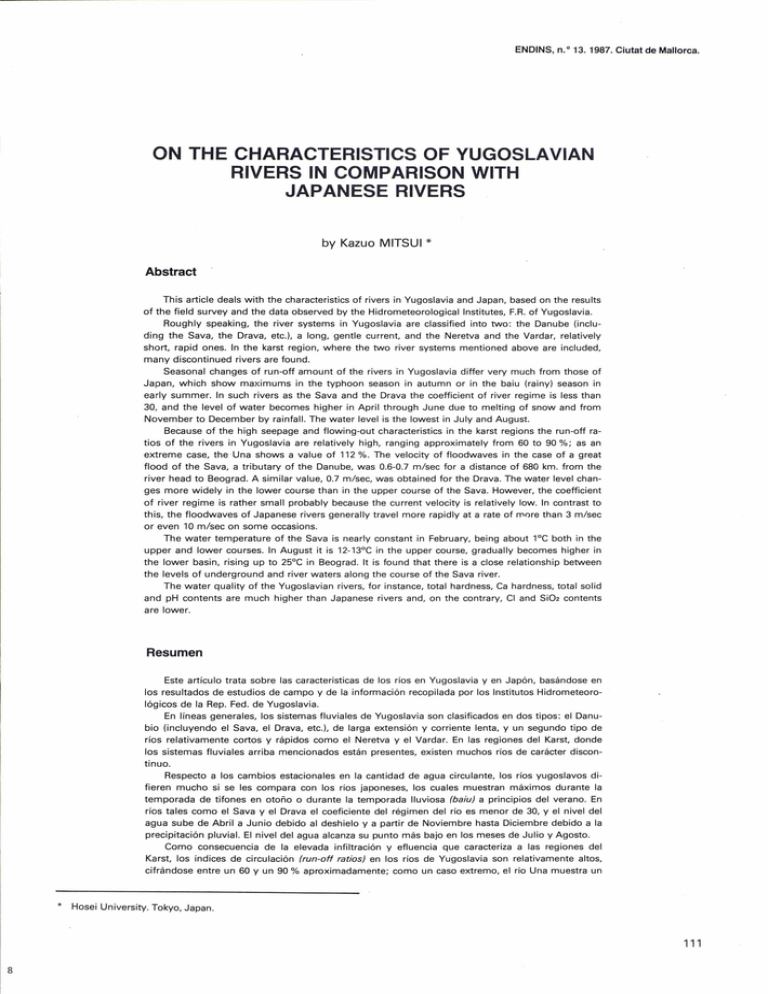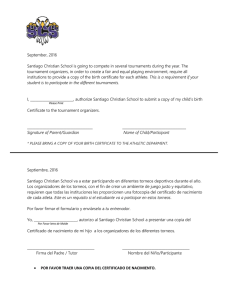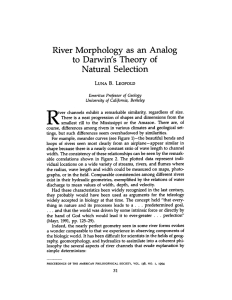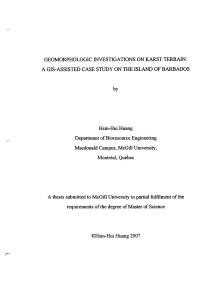ON THE CHARACTERISTICS OF YUGOSLAVIAN RIVERS
Anuncio

ENDINS, n." 13.1987. Ciutat de Mallorca. ON THE CHARACTERISTICS OF YUGOSLAVIAN RIVERS IN COMPARISON WlTH JAPANESE RIVERS by Kazuo MITSUI * Abstract This article deals with the characteristics of rivers in Yugoslavia and Japan, based on the results of the field survey and the data observed by the Hidrometeorological Institutes, F.R. of Yugoslavia. Roughly speaking, the river systems in Yugoslavia are classified into two: the Danube (including the Sava, the Drava, etc.), a long, gentle current, and the Neretva and the Vardar, relatively short, rapid ones. In the karst region, where the two river systerns mentioned above are included, many discontinued rivers are found. Seasonal changes of run-off amount of the rivers in Yugoslavia differ very much from those of Japan, which show maximums in the typhoon season in auturnn or in the baiu (rainy) season in early sumrner. In such rivers as the Sava and the Drava the coefficient of river regime is less than 30, and the level of water becomes higher in April through June due to melting of snow and from November to December by rainfall. The water level is the lowest in July and August. Because of the high seepage and flowing-out characteristics in the karst regions the run-off ratios of the rivers in Yugoslavia are relatively high, ranging approximately from 60 to 90 %; as an extreme case, the Una showc a value of 112 %. The velocity of floodwaves in the case of a great flood of the Sava, a tributary of the Danube, was 0.6-0.7 m/sec for a distance of 680 km. from the river head to Beograd. A similar value, 0.7 m/sec, was obtained for the Drava. The water level changes more widely in the lower course than in the upper course of the Sava. However, the coefficient of river regime is rather small probably because the current velocity is relatively low. In contrast to this, the floodwaves of Japanese rivers generally travel more rapidly at a rate of more than 3 m/sec or even 10 m/sec on some occasions. The water temperature of the Sava is nearly constant in February, being about 1°C both in the upper and lower courses. In August it is 12-13°C in the upper course, gradually becomes higher in the lower basin, rising up to 25°C in Beograd. It is found that there is a close relationship between the levels of underground and river waters along the course of the Sava river. The water quality of the Yugoslavian rivers, for instance, total hardness, Ca hardness, total solid and pH contents are much higher than Japanese rivers and, on the contrary, CI and Si02 contents are lower. Resumen Este artículo trata sobre las características de los rios en Yugoslavia y en Japón, basándose en los resultados de estudios de campo y de la información recopilada por los Institutos Hidrometeorológicos de la Rep. Fed. de Yugoslavia. En líneas generales, los sistemas fluviales de Yugoslavia son clasificados en dos tipos: el Danubio (incluyendo el Sava, el Drava, etc.), de larga extensión y corriente lenta, y un segundo tipo de ríos relativamente cortos y rápidos como el Neretva y el Vardar. En las regiones del Karst, donde los sistemas fluviales arriba mencionados están presentes, existen muchos rios de carácter discontinuo. Respecto a los cambios estacionales en la cantidad de agua circulante, los rios yugoslavos difieren mucho si se les compara con los rios japoneses, los cuales muestran máximos durante la temporada de tifones en otoño o durante la temporada lluviosa (baiu) a principios del verano. En ríos tales como el Sava y el Drava el coeficiente del régimen del río es menor de 30, y el nivel del agua sube de Abril a Junio debido al deshielo y a partir de Noviembre hasta Diciembre debido a la precipitación pluvial. El nivel del agua alcanza su punto más bajo en los meses de Julio y Agosto. Como consecuencia de la elevada infiltración y efluencia que caracteriza a las regiones del Karst, los indices de circulación (run-off ratios) en los rios de Yugoslavia son relativamente altos, cifrándose entre un 60 y un 90 % aproximadamente; como un caso extremo, el río Una muestra un Hosei University. Tokyo, Japan. valor de 112 %. La velocidad de las olas de crecida durante una gran inundación del río Sava, afluente del Danubio, fue de 0,6-0,7m/seg en una distancia de 680 kilómetros, desde la cabecera del río hasta Belgrado. Un valor similar fue obtenido durante una crecida de río Drava. Los niveles del agua cambian más ampliamente en el curso bajo del Sava que río arriba. Sin embargo, el coeficiente del régimen del río es más bien pequeño debido quizás a que la velocidad de la corriente es lenta. Al contrario de lo anterior, las olas de crecida de los ríos japoneses avanzan más deprisa, a una velocidad que supera los 3 m/seg o incluso los 10 m/seg en algunas ocasiones. La temperatura del agua en el rio Sava es casi constante en Febrero, siendo de aproximadamente 1°C tanto en el curso alto como río abajo. En el mes de Agosto es de 12-13OC en la parte de la cabecera del río, elevándose gradualmente aguas abajo hasta llegar a 25OC en Belgrado. Se comprueba que existe una fuerte correlación entre los niveles de las aguas subterráneas y de las aguas del río a lo largo del curso del Sava. La calidad del agua en los ríos de Yugoslavia, por ejemplo la dureza total, el contenido en calcio, la cantidad total de sólidos y el pH dan valores mucho más altos que en los ríos japoneses, y por el contrario, la clorinidad y el contenido en Si01 con inferiores. 1. lntroduction This article deals with the characteristics of rivers in Yugoslavia, a widely developed karst region and Japan, a volcanic country, based on the results of the field survey and the data observed by the Hidrometeorological Institutes, F.R. of Yugoslavia. Roughly speaking, the river systerns in Yugoslavia are classified into two: the Danube (including the Sava, the Drava, etc.), a long, gentle current, and the Neretva and the Vardar, relatively short, rapid ones. In the karst region, where the two river systems mentioned above are included, many discontinued rivers are found (Figs. 1-6). Figure 2. Distribution of Volcanic front around Japan (by Sugimura). 1 : active volcano. 2: other quaternary volcano. Figure 1. Distribution of the river systems in Yugoslavia. 1: frontier. 2: watershed. 3: river. 4: observation point. 5: city. Figure 3. Distribution of analysed water quality of Japanese Rivers. by Dr. J. Kobayashi (1960). Figure 5. Distribution of limestone and Karst region, and rnain rivers in Yugoslavia. 1: east boundary Karst region. 2: limestone. Discussion 1) Run-off percentage and coefficient of river regime Figure 4. Distribution of limestone and rnain stalactitic cave in Japan. 1: Akiyoshi. 2: Hirao. 3: Taisyaku. 4: Shikoku. 5: Ryuga. 6: Atetsu. 7: Ryusen. 8: Akka. 9: Toma. 10: Nakatonbetsu. Seasonal changes of run-off arnount of the rivers in Yugoslavia differ very rnuch frorn those of Japan, which show rnaxirnurns in the typhoon season in auturnn or in the baiu (rainy) season in early surnrner. In such rivers as the Cava and the Drava the coefficient of the river regirne is less than 30, and the level of water becornes higher in April and continues until June due to rnelting of snow and from November to Decernber due to rainfall. The water level is the lowest in July and August (Fig. 7). Figure 6. Longitudinal profile of main rivers in Yugoslavia. DRAVA VRVAS VARDAR BOSNA ARAKAWA (Japan) SAVA DRINA V. MORAVA UNA , NERETVA Figure 7. Seasonal change of run-off arnount (average of 19561966) of the rnain rivers in Yugoslavia and R. Arakawa in Japan. Due t o the high seepage and flowing-out characteristics in the karst regions the run-off ratios of the rivers iiI Yugoslavia are relatively high, ranging approximately from 60 to 90 %; as an extreme case, the Una shows a value of 112 % (Table 1). upper and lower courses. In August it is 12-13°C in the upper course, gradually becoming higher in the lower basin, rising up to 25°C in Beograd. It has been discovered that there is a close relationship between the levels undergound and river waters along the course of the Sava river (Fig. 8). 2) The velocity of floodwaves The velocity of floodwaves in the case of the great flood of the Sava, a tributary of the Danube, was 0.6-0.7 m/sec for a distance of 680 km from the river head to Beograd. A similar value, 0.7 m/sec, was obtained for the Drava. The water level changes more widely in the lower course than in the upper course of the Sava. However, the coefficient of the river regime is rather small probably because the current velocity is relatively low. In contrast to this, the floodwaves of Japanese rivers generally travel more rapidly at a rate of more than 3 m/sec or even 10 m/sec on some occasions. Cm 600- P m 400- Si - P m m- r m m e r - I 1000 The water temperature of the Sava is nearly constant in February, being about 1°C both in the 1 NO. o-100 3) The water temperature 2 . % - 0 . 7 6 ~ r=+0.75 I 800 I I 600 I 1 I 400 U.G.WATER LEVEL I I I 200 Figure 8. Relationship between groundwater level and river water in Sava river basin. 4) The water quality The water quality of the yugoslavian rivers, for exarnple, total hardness, Ca hardness, total solid and pH contents are rnuch higher than Japanese rivers but contrary to this, CI and Si02 contents are lower. 5) The characteristics of the lnland-water in Slovenia 1. Alrnost al1 parts of Slovenia are on the Dinaric Karst with rnountains, hills and plateaus of limestone which belonas to the Pre-Cretaceous Deriod. It's typical topography includes doline, uvala, ponor, karren and stalactitic caves. For this reason, river water ofien flows into the ground and then springs out and sornetirnes flow into the caves again. . 2. The river systerns can be roughly classifiea into two the Vipava and SoCa River systems in the western part and the Ljubljana and Cava systerns in the eastern part of the country. The river systerns in the former part tend to continue to run on the ground surface for long distances. On the other hand, those in the latter part seern to have been developed by the Reka, Pivka and Unica Rivers, which run into caves several times and it is difficult t o determine, where the end of the river is (Fig. 9). 3. In cornparing the quality of the water systerns of the Vipava and SoEa Rivers wifh that of Ljubljana and Sava Rivers, we find that the regional difference of the total hardness and total solid are higher in the latter systerns. However, both of thern have cornrnon characteristics of the rivers running in the Karst region: that is, their total hardness, Ca hardness, total solid and pH contents are - Figure 9. Distribution of the river systems and obsewated points in Sovenia. rnuch higher than Japanese rivers and, on the contrary, CI and Si02 contents are lower (Table 2). 4. It seerns that the flow of surface water as well as cave water is closely related to rainfall, this relation to the systerns is not yet clear. 5. Changes in the quality of water, particularly the hardness, are related to the run off arnount and ternpeature, but .this does not rnean that an increase in water flow by rainfall rnay cause a lowering in the concentration of the cornponents of water. In the case of the cave water the relationship is more cornplicated by the varying depths of the ground surface to the water, and types of vegetation land over the caves. 6. As rnentioned by Prof. lvan Garns, the limestone in this area has a corrosion intensity of more than 50-60 rn3/krn2.Sornetirnes more than 100 r n 3 / km2 in a certain srnall area, which has rnuch annual Figure 10. Regional distribution of solution in Karst region, Yugoslavia (by Prof. l. Garns). A B C Wien Maribor Radece Danube Drava Sava Metlika Martin Brod Banja Luka Usora Zvornik Ljub Most Kupa Una Vrbas Bosna Drina V. Morava Solkan Konjic Radusa Sota Neretva Vardar Basel París Rhein Seine Elbe Ohio Mississippi 32,p resde den Pittsburgh Minnesota O Kawaguchi Tome Kajikasawa Kunhashi -CD Arakawa E F - - 0.121 0.215 0.57 0.57 4 29 28 111,850 111,400 0.151 0.179 0.107 0.109 0.133 0.242 0.61 1.12 0.76 0.59 0.85 0.33 81 53 27 57 26 36 - 0.188 0.244 0.266 0.80 0.94 0.80 91 55 11 11460 1'1500 - - - - - - 0.177 0.78 - gL Kitakami 2 D Fujikawa Tonegawa - - - - - 14 34 82 364 119 149 223 400 850 - - - Table 1: River regimes of the main rivers in Yugoslavia and others A. obse~ationplace B. river name C. ratio of seasonal changes of run-off amount of rivers D. run-off percentage E. coefiicient of the river regime F. river-bed slope Ca mgll Mg mgll Na mgll K mgll HCO, mgll HCO, mell SO, mgll CI mgll SiO, mgll Fe mgll PO, NO,-N mgll mgA Hokkaido (22 rivers) 8.3 2.3 9.2 1.45 33.9 0.55 10.7 9.0 23.6 0.50 0.01 0.54 0.06 87.9 76.9 Tohoku (35 rivers) 7.7 1.9 7.3 1.06 19.9 0.33 17.6 7.9 21.5 0.49 0.01 0.26 0.06 79.1 18.6 Kanto (11 rivers) 12.7 2.9 7.3 1.43 42.4 0.69 15.9 6.1 23.1 0.23 0.03 0.29 0.08 93.5 22.1 Chubu(centralpart) (42 rivers) 8.9 1.7 4.8 1.05 30.1 0.49 7.7 3.9 13.7 0.14 0.02 0.18 0.05 62.0 26.9 Kinki (28 rivers) 7.6 1.3 5.5 1.04 27.4 0.45 7.4 5.3 12.1 0.11 0.01 0.21 0.04 56.8 20.0 Chugoku (western part) (25 rivers) 6.7 1.1 6.5 0.94 27.2 0.45 4.4 6.6 14.1 0.05 0.00 0.20 0.03 56.7 7.4 Shikoku (19 rivers) 10.6 1.5 3.8 0.66 37.2 0.61 5.7 2.4 9.8 0.01 0.00 0.12 0.02 5i.0 6.1 Kyusyu (43 rivers) 10.0 2.7 8.6 1.84 40.9 0.67 13.1 4.6 32.2 0.13 0.04 0.20 0.04 106.0 29.8 8.8 1.9 6.7 1.19 31.0 0.51 10.6 5.8 19.1 0.24 0.02 0.26 0.05 . 74.8 29.2 All Japan (225 nvers) Table 2: Average river water quality of each region in Japan (by J. Kobayashi, 1960) NH,-N evaporation suspended mgll residue matter mgll mgll Figure 11. Distribution of evaporation residue of the rivers in Slovenia (in winter, 1970). rainfall and dense forests (Figs. 10, 11). 7. Even in a country town like AjdovSEina, the river water is polluted to a great extent, when it flows through the urban area. However, it is selfpurified and becomes as clean as it was during the time flowing down several kilometers, because the pollution load is not very great at present. 8. Similar characteristics to these are found in Akiyoshi Cave, a typical karst region of Japan. But these similarities are small, if we compare them in detail with those in the whole region of Slovenia.



